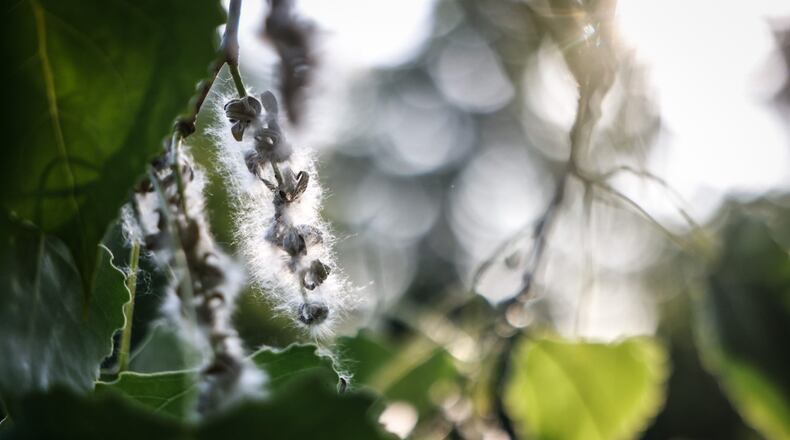“We’re pretty much in pollen season. Right now, we have our grass and tree counts have been relatively high as of recently, which is not uncommon for this time of year,” said Brian Huxtable, air pollution control specialist with the Regional Air Pollution Control Agency.
Cottonwood trees have also recently been shedding seeds, causing a flurry of white tufts of hairs called pappi to disperse the seeds through the wind, but it’s difficult to say if that is part of what’s irritating people’s allergies.
“Everybody has different allergies,” Huxtable said.
Local doctors say their patients have been having a hard time with itchy eyes, nose and throat, along with congestion, sneezing, runny nose and eyes, post nasal drip (drainage in the throat), fatigue, and coughing.
“It’s been a rough spring,” said Dr. Charles DeBrosse, board certified allergist and immunologist with the Allergy and Asthma Centre of Dayton. More than once, DeBrosse has heard patients calling this the worst spring ever for them.
“What we’ve been seeing is that spring started a little early this year. It was kind of warm in February, and tree pollen came out a little early, and because the pollen season’s been longer, I think it’s been a little bit harder,” DeBrosse said.
Throughout February, March, and April, grass and tree pollen would spike with the warm weather, and then with rain, temperatures would cool off and pollen would go down, DeBrosse said. People with allergies would feel bad and then they would get better, but that pattern seems to be disrupted with the consistently warm, dry weather.
“I would say in the past two weeks, people have come in consistently miserable,” DeBrosse said. “Now that it’s been warm, and it’s stayed warm, our patients have been coming in, telling us it’s really been a rough past couple of weeks.”
In addition to regular symptoms, some patients are also experiencing asthma exacerbation with the intense allergy season.
“This past week has been really hard,” DeBrosse said. People allergic to both tree and grass pollen have been hit with the elevated pollen counts continuing under both those categories.
Along with tree and grass pollen, ragweed pollen is already showing up when ragweed traditionally appears in August and the fall. There are high concentrations of tree and grass pollen projected for the Dayton region.
“Ragweed usually doesn’t come out until the fall,” DeBrosse said. “Right now, people who may have normally not suffered with their symptoms until the fall, they may be bothered already.”
Those looking for relief can try over-the-counter allergy controllers or antihistamines, as well as nasal sprays. Doctors also recommend starting with the steroid nasal sprays early to help prevent or lessen the impact of future symptoms.
“There’s a lot of over-the counter-remedies,” Williams said. “I’m a big proponent of intranasal steroids.” Williams starts using his nasal sprays in mid-March to prepare for allergies later in the spring.
People should also keep their windows closed and use their air conditioners if they’re able to in order to keep the pollen outside, both Williams and DeBrosse said. Those working outside should also change their clothes once they come inside, either showering or washing their face in order to remove the pollen. Those whose allergies are aggravated by grass pollen can also try wearing a face mask when mowing the grass to prevent inhaling the pollen.
For people having a particularly rough time with allergy symptoms that aren’t letting up, they can reach out to their primary care doctor. Prescription medications are available, as well as allergen immunotherapy.
Conditions causing people’s allergies to flare up aren’t expected to go away soon.
“It’ll likely continue,” Williams said. Eventually the pollen in the air will change, hopefully giving some people a break in the future. “A lot of it just depends on what your allergy is,” he said.
About the Author

